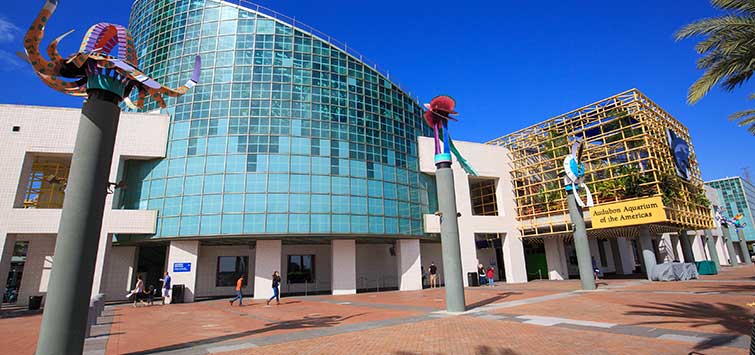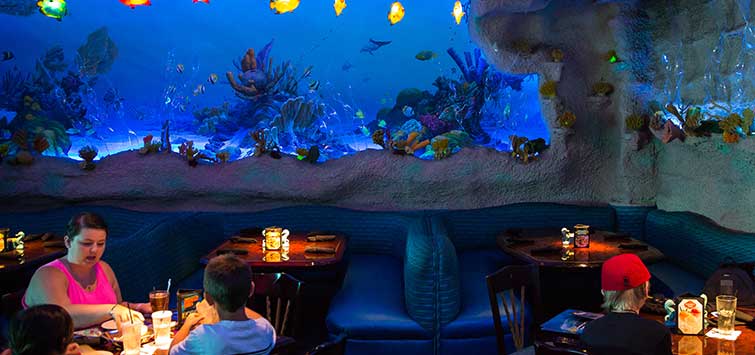Aquariums in Architecture- A Really Big Reef Tank: Red Bank Veterinary Hospital's 2000-gallon Circular Reef
Author: Nicholas Violand
Our Editorial Assistant reports on his visit to this massive cylindrical display, and gives us a behind-the-scenes look as well.
I’ve always dreamt of building a monstrous aquarium in my own home; however, facing reality, most of us with this dream realize the stakes are against us. To satisfy my curiosities about how such an installation comes to fruition, I visited the Red Bank Veterinary Hospital in Tinton Falls, New Jersey, where Jeff Turner and his team at Reef Aquaria Design have built a monumental 2000-gallon reef display.
The tank was constructed in 2004, during the same time the hospital itself was being constructed. One could say that a large portion of the hospital was architecturally designed and built around this reef installation. The triple-layered curved panes of 1½-inch thick glass were lowered by crane onto the base in three sections, then lowered through the roof, and a great deal of caution went into ensuring the display did not leak. With everything built rather solidly, the entire system is said to be leak- and disaster-proof. Any loss of power to the system’s pumps would result in water being emptied into a secondary sump on a below-ground level of the building, rather than all over the floors of the hospital.
The Display
To put this all into perspective, the installation lies in the center of the hospital’s reception and waiting-room area—it’s about 9 feet tall and is cylindrical, with everything else in the room wrapped around this giant work of art. The reef attributes almost half of its height to a massive cement cylinder upon which it sits at about 4 feet from the floor, and the rest of the room mimics the round edges of the tank’s glass panels, from the hospital’s reception desks out to the walls of the room itself. At about 2000 gallons, the aquarium spans 8 feet in diameter, and houses numerous and varied reef fishes (see sidebar p. 124) and invertebrates.
In the center of the cylinder lies a mountainous, aquacultured live rock structure built around a center column with four overflows that feed three drains. The corals in the display are drenched by four 20K and four 10K fluorescent bulbs, and eight 400-watt metal halides, all radiating from a custom-welded rack attached at the center overflow box. These lights are timed so that the blue- and white-spectrum lights come on one hour apart from one another, with total illumination over a period of 11 hours.
The only equipment in the same room as the display tank is the lighting ballasts and timers, and a pair of alternating wavemakers, which switch the flow in the tank from clockwise to counter-clockwise every five minutes via automated valves. While viewing this huge reef aquarium was definitely not an everyday opportunity, those three drain pipes in the center of the overflow column led to what may be an even more awe-inspiring sight: the pump room.
The Pump Room
After some initial gawking at the amazing display, I traveled down a few long corridors and took an elevator one floor down, following Austin Sweerus, who maintains the reef on a regular schedule, into the room I had been waiting to see. Behind large double doors were three large sumps, a 100-gallon refugium, four propagation tanks, and a protein skimmer you’d have to see to believe.
The two smaller sumps sit in the center of the room, each a 500-gallon cylindrical container, one serving as a reservoir for water changes, the other as an overflow. The largest is 700 gallons in capacity and serves as the primary sump for the display, fed with water directly from the largest drain. (That drainpipe actually splits again, with two other tubes going to different components.) The huge, thick polypropylene container is so large that during construction it had to be brought into the room in two halves, and was then welded together once inside. Water movement is minimal here so any large particles are permitted to settle and collect at the bottom of the sump, rather than in the display.
Refugium
Atop this massive sump is the refugium, housing different types of macroalgae: chaetomorpha; Caulerpa polifera, commonly called “sea grass”$$ and C. racemosa, or grape caulerpa, all lit by two 300-watt metal halide pendant fixtures. The container is not filled to capacity with water, but has several inches of mud at the bottom to further aid in water purification. Feeding it is the second of the three pipes running off of the largest drain from the display upstairs.
The third of these pipes leads to a 50-gallon reactor tub, where a large calcium reactor and phosphate reactor sit, both churning away, one to enrich the calcium levels in the water with the sand it houses, and the latter to remove phosphate. A CO2 tank is also fed into this line, supplying CO2 via tandem diffusers at a rate of one bubble per second each. The skimmer sits at one end of the 700-gallon sump, about 6 feet tall. The unit is custom built, venturi driven, and is topped by a skimmate-collection cup nearly the size of a nano reef I have at home. Able to collect more than one-half gallon per day, the skimmer seemed to be doing its job on this heavily stocked system, as the cup was filled with the nasty brown liquid that tells you your skimmer is working well. The water from the reactors and the skimmer collect in the second sump, which is 500 gallons in capacity and also serves as an emergency overflow.
Water Pumps
After passing through the refugium, reactors, and skimmer, water that collects in one of the sumps is pumped back into the display by a large 1½-hp pump. On its way, the water passes through two UV sterilizers, containing eight 40-watt UV bulbs in all. From the second sterilizer, water then travels through a heat exchanger, which operates via a large cooling unit on the roof of the hospital—much like a large building’s air conditioning unit. Surprisingly, no additional heating equipment is needed; but considering the wattage over the display and the refugium, it makes sense that supplemental heating is not necessary. All of the water is kept at a constant one-degree differential, between 78° and 79°F. With all the equipment running in the pump room, an air conditioner is constantly running, keeping the room at 66°F.
Forgot about those other two drains from the main display? Each one feeds into a closed loop with an additional 1½-hp pump feeding the wavemakers in the display. One pump outlets in the display from the live-rock structure in a clockwise direction around the cylinder. When this loop is automatically closed, the other opens up, so water can then flow in a counter-clockwise direction. As mentioned above, the controls for the wavemakers are set up inside the cylindrical base of the display, and each of these pumps is attached to its own dedicated electrical circuit, with ground-fault interruption, of course.
The second of the two smaller sumps is not directly tied into the line, but is linked up to the 7-stage RO/DI system. Attached to the wall are sediment filters, carbon filters, RO membranes, and deionization cartridges. Producing about 100 gallons per day, the fresh water enters the sump, which is controlled by a float kit. A kalkwasser reactor is tied into this sump, churning additional calcium additives and depositing the mixture into the sump, where salt water is mixed. Looking at the bottom of the container, precipitated calcium could be seen collecting.
That’s not the end of the pump room just yet. Opposite the sumps, reactors, and skimmer are four propagation tanks, neatly lined up. Each one is outfitted with a 150-watt metal halide pendant fixture. While the tanks had nothing but water and some live rock in them at the time of my visit, Austin hopes to fill them with separate batches of corals, to put the metal halides to good use. In the first tank he plans to keep frags of mushrooms and small polyps; and in the second, small frags of acropora and other stony corals. The third tank would be reserved for growing out larger pieces of various corals, with the last one being reserved solely for chaetomorpha, a favorite macroalgae that grows rather rapidly.
Regular Maintenance
Aside from cleaning the tank glass both inside and out on his maintenance trips three times a week, Austin adds 10 to 15 cups of carbon to bags placed along the flow lines near the reactors and sumps every other week. Also added are 400 ml of calcium (and an alkalinity buffer), 200 ml of iodine, and 200 ml of strontium, each three times weekly. Based on how much water has evaporated, one-quarter cup of kalkwasser mix is added to the kalkwasser reactor once a week as well. The calcium reactors are filled two times annually. He does at least a 10-percent water change (10 percent of the display’s volume) either once a week or once a month, depending on algae growth, which means about 200 or 300 gallons, depending upon how long it takes to siphon out all the detritus.
Display Inhabitants
The protein skimmer in the pump room definitely works hard for a reason. According to the list Austin supplied, the 2000-gallon display houses well over a hundred fish—and it doesn't seem at all overstocked!
I mentioned that Austin maintains the reef three times a week—so how are the fish fed, you may ask? Two well-hidden automatic feeders release dry food five times a day; and on Austin’s visits, he gives the fish frozen foods to supplement.
Invertebrates
Among the invertebrates are two large Tridacna derasa clams and one huge T. gigas clam, which must be about a foot in length. Although the mantle of the large clam is slightly receded on one end, it has all its color and seems to be doing well. A trio of clowns were spotted playing in and around this huge bivalve. Also, three Diadema setosum urchins live in the display, with their huge black spines sticking out from different spots in the rockwork. The reef is home to numerous tuxedo urchins, brittle stars, snails, hermit crabs, and sea biscuits as well.
Corals
There are many different types of corals in the display, most noticeable being the various types of Acropora, frogspawn and hammer corals (Euphyllia), and numerous types of zoanthids, leather corals, and mushrooms. Of particular interest is a thick colony of bird’s nest coral, with two of the five hawkfish perching among the thicket. Unfortunately, I had just missed seeing a rather large colony of frogspawn growing on one side of the reef, which for some reason had split into many smaller fragments about a week before my visit. Most surprising to me were the random yellow patches of the difficult-to-keep Goniopora, which had reproduced and spread all over the reef.
Closing Thoughts
Seeing the success of this monumental reef display—the system in total having a capacity of about 3500 gallons—was definitely an experience I will remember for quite some time. I left the Red Bank Veterinary Hospital plotting out my next reef upgrade in my head, realizing that a display as beautiful and massive as the one I had just seen would always be only the reef of my dreams.
Acknowledgments
I would like to thank Jeff Turner and his team at Reef Aquaria Design for putting together such a wonderful display, Austin Sweerus for giving me an in-depth tour of the entire system, and Karin Kandur and the rest of the staff at the Red Bank Veterinary Hospital for their greatly appreciated cooperation and enthusiasm.
See the full article on TFH Digital http://www.tfhdigital.com/tfh/200803/#pg123

.png?h=595&iar=0&w=2781&hash=5FD5E69473BCC22199FBFA2FB71B6033)



